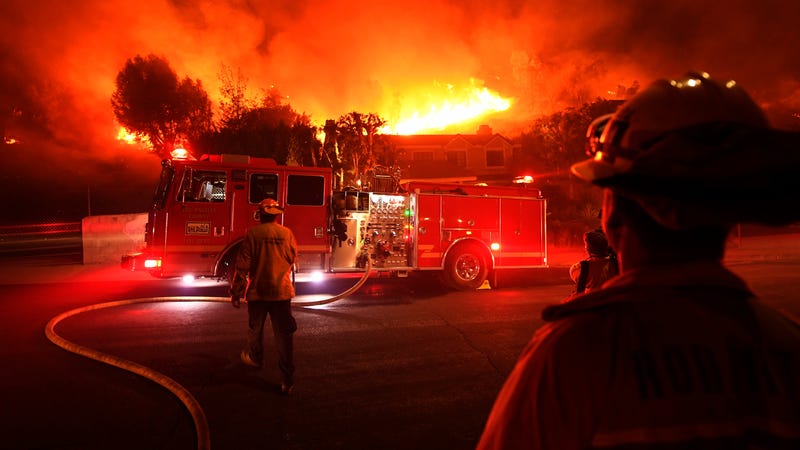#California_Is_Using_Slave_Labor
کالیفرنیا_از_کار_برده_ای_برای_مبارزه_با_آتش_سوزی_استفاده_میکند#
#to_Fight_the_Wildfires
ترجمه مختصراز: پیمان پایدار
Photo: Kevork Djansezian (Getty Images)
Yesterday, I vacuumed the stairs.
There was a time when I would make my daughter do it but that was before I bought a high-end vacuum cleaner and she acted as if it was such a monumental chore. I secretly think she intentionally clogged it once so I’d stop asking.
It worked.
I know I’m a softie, but I stopped asking when I heard her mumble one of the same phrases I would use when I was a teenager.
When I was her age, exhausted from a long day of telling me and my sisters to wash dishes, take out the garbage and bring her a glass of water (I still contend that she may have been the most well-hydrated mother on the planet), my mom would use her powers of supersonic hearing to respond to our mumbles of “slavery days are over,” with the retort: “Not in this house!”
The Oxford English Dictionary defines a slave as, “(especially in the past) a person who is the legal property of another and is forced to obey them, ” including:
1.1 A person who works very hard without proper remuneration or appreciation.1.2 A person who is excessively dependent upon or controlled by something.
According to the U.S. Census, in 1860, there were 3,953,761 slaves in America. The Bureau of Justice Statistics’ 2016 report on the prison population says that on December 31, 2016, an estimated 6,042,500 persons were supervised by U.S. adult correctional systems. That number does not include people in local prisons who were not convicted of a crime.
That means, in 2018, 6 million men, women and children can be threaded through the constitutional loophole and turned into throwback chattel.
Slavery days are not over.
As two deadly wildfires ravage California homes, killing at least 31 people and leaving hundreds homeless, the state of California is hoping to contain the fires using one of America’s oldest, most expendable forms of labor. The Associated Press reports that 200 inmates from 16 prison crews are being used to fight the Camp Fire, the deadliest wildfire in state history.
An ABC10 report in August notes that the inmates used to fight California’s wildfires are “volunteers,” from the 44 “conservation camps” in 29 counties in the state who “earned” the right to fight wildfires.
So why would anyone call them slaves?
Well, there is a list of reasons, all of which reference the literal definition of slavery:
- They don’t receive “proper remuneration”: While fighting fires, inmates earn an average of $2 per day and a whopping total of $1 per hour. But relax, the inmate-firefighters are also paid with credit. According to ABC10: “Two days of credit for every day of incarceration (or 66.6 percennt) are awarded to nonviolent offenders serving in fire camps
- They “work very hard”: They work in 24-hour shift alongside firefighters who are being paid, including overtime. Aside from fighting fires, a California attorney describes the work as “clearing fire breaks, loading sandbags for future uses, restoring historical areas, maintaining parks and clearing dead, dry brush that is a fire hazard.”
- The program contributes to mass incarceration: In 2014, a Deputy Attorney General argued that releasing California inmates would “severely impact fire camp participation, a dangerous outcome while California is in the middle of a difficult fire season and severe drought.”
- A recent candidate for Lieutenant Governor called it “slave labor”: Gayle McLaughlin, former mayor of Richmond, Calif., in her run for lieutenant governor of California said: “No matter how you may want to dress it up, if you have people working for nothing or almost nothing, you’ve got slave labor, and it is not acceptable.”
- They are tricked into slavery: One of the biggest incentives the program offers is the prospect of working as a firefighter upon release. But USA Today notes that almost every county in California requires firefighters to be licensed as an Emergency Medical Technician, which is usually denied to anyone with a criminal record. California is ranked as the “worst licensing environment for workers in lower-income occupations,” according to one report.
- You could literally die: At least two inmates died fighting fires in 2017, according to the Daily Beast, and five in total.
- Some of them are juveniles: One of the fire camps is exclusively for juvenile inmates. In July, the California Department of Corrections tweeted that 58 youthful offenders were battling the Mendocino blaze that scorched 350,000 acres and 146 homes. And it’s not just California, in Oregon, inmates as young as 16 are used to battle the wildfires.
It is important to note that Blacks are 5.9 percent of California’s residents but make up 29 percent of the state’s prison population. The Sentencing Project notes that the Golden State incarcerates 8.8 black people for every white person it imprisons.
So during a 24-hour shift, you could earn as much as $26 fighting a fire ... Or you could die. It sounds like slavery. It looks like slavery. It fits the definition. Even worse, it is 100 percent legal.
But sometimes, people are forced to work “very hard without proper remuneration or appreciation,” which is why there are two things we should never forget:
- Slavery days are not over.
- Yesterday, I vacuumed the stairs.


No comments:
Post a Comment